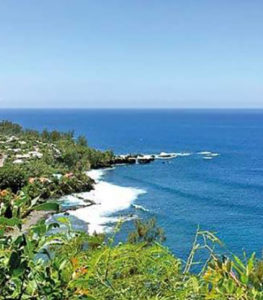An Indian Ocean island that is attracting asylum seekers
 The latest destination for Sri Lankan asylum seekers fleeing the fallout from the nation’s decades long civil war – and the latest political twist in the saga – is the tiny French administered island of Reunion, about 800 kilometres off the east coast of Madagascar.
The latest destination for Sri Lankan asylum seekers fleeing the fallout from the nation’s decades long civil war – and the latest political twist in the saga – is the tiny French administered island of Reunion, about 800 kilometres off the east coast of Madagascar.
In March last year, six Sri Lankans arrived on a raft after being left without food or water when their boat sank.
They had travelled 4,000km across the Indian Ocean and they were followed by four more boats that have brought 145 Sri Lankans to Reunion in less than a year.
On 5 February this year, the latest and largest boatload arrived with 72 people on board, including eight women and five children.
On 14 February, 64 were deported after their asylum appeals were rejected.
Reunion, a former French colony which neighbours Mauritius, became an overseas department of France in 1946.
There is a steady trickle of asylum-seekers from nearby African islands but its new-found appeal for Sri Lankan asylum seekers has caught French authorities off-guard.
From 2016 to 2018, the island received 105 asylum applications. Sri Lankans accounted for most requests, followed by Indians and Comorians, according to the prefecture of Reunion.
Reunion is just 2,500 square kilometres and has a population of less than a million.
Observers say the Sri Lankans did not end up at Reunion by chance. Four of the five boats arrived in the middle of cyclone season.
Reports say people smugglers are promoting the island as a destination with videos and promising to arrange passage for about $US 2,800.
A decades-long Tamil rebellion in northern Sri Lanka that was crushed in 2009 is at the root of many desperate bids to leave.
Though the conflict officially ended in 2009, Tamil advocates say persecution of the minority group persists today and is a push factor.
Added to this is a political crisis that unfolded in Sri Lanka last year.
Mahinda Rajapaksa, the former President and the driving force behind the government offensive that crushed the Tamil rebellion, laid claim to the premiership in a bid to remove Ranil Wickremesinghe, the current Prime Minister.
Rajapaksa later backed down but the resurgence of the popular Sinhala-Buddhist leader in Sri Lankan politics sparked fears of aggression against those connected to the rebellion, and against minorities.
Sri Lanka is a Buddhist-majority country with a significant population of Hindus – 12.6 per cent, Muslims – 10 per cent and Christians – 7.5 per cent.
Though most Sinhalese are Buddhists and most Tamils are Hindus, there are also Tamil and Sinhalese people who practice Christianity.
Some of the Sri Lankans who have arrived on Reunion are Christians.
Reunion was settled and colonised by the French in the 17th century and remained largely in French hands with a brief spell of British rule.
Coffee plantations were established after colonisation, soon to be overtaken by sugar plantations that continue to be the mainstay of the economy.
When slavery was abolished in 1848, wage labour was imported from India, China and Africa to work on the plantations. Christianity is the predominant religion but there are significant communities of Hindus and Muslims.
The island’s religious pluralism has attracted not just Sri Lankans, but Indians, as well.
Two Indian Muslims are currently seeking asylum on the grounds that an increasingly assertive Hindu nationalism poses a threat to them.
Laurie Nowell
AMES Australia Senior Journalist












